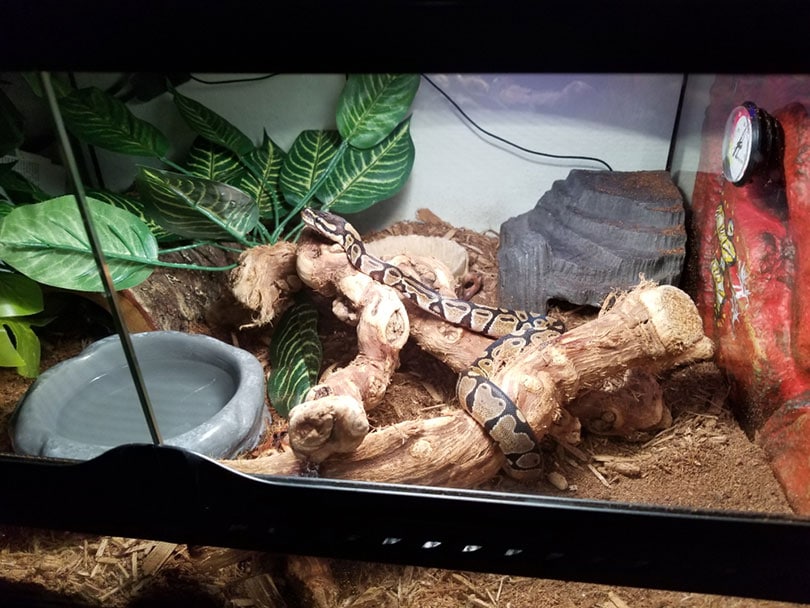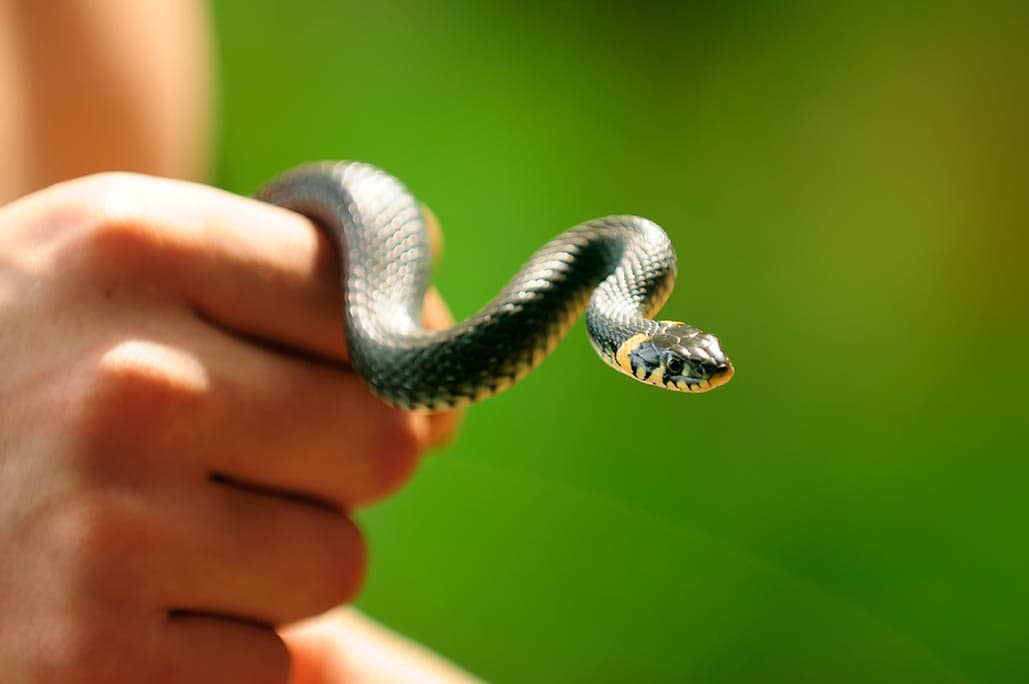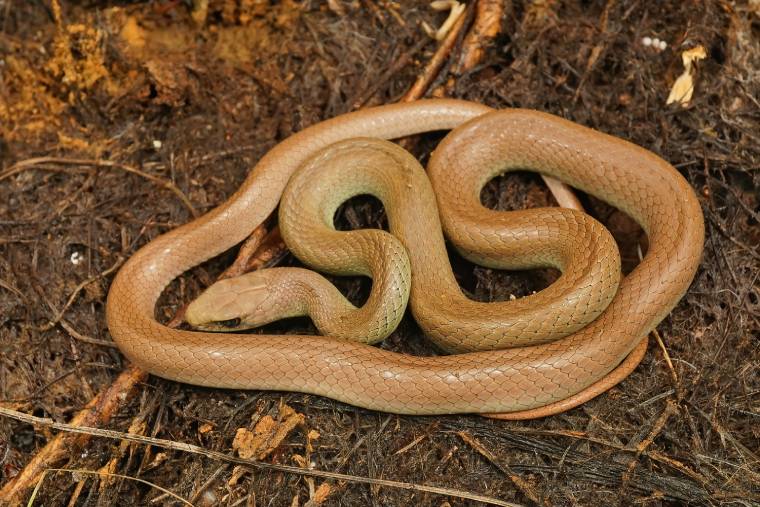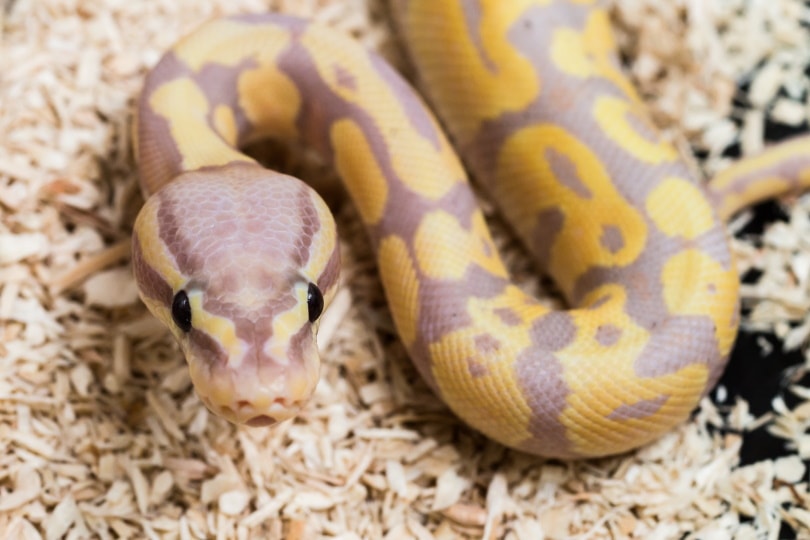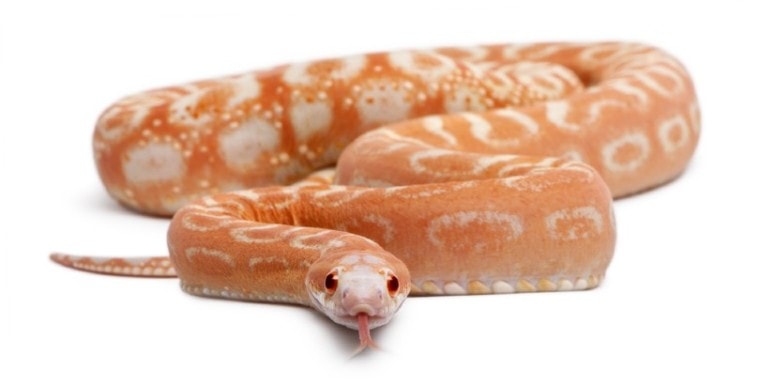
While snakes have a bad rap in many homes, they do make excellent pets, and the Scaleless Corn Snake is an outstanding choice for both beginner and expert handlers. But why are they such a great choice, and how much do they cost?
In this guide, we break down everything that you need to know to identify, care for, and purchase one of these beautiful reptiles.
Quick Facts About Scaleless Corn Snake
| Species Name: | Pantherophis guttatus |
| Common Name: | Scaleless Corn Snake |
| Care Level: | Low |
| Lifespan: | 20 to 25 years |
| Adult Size: | 2 to 6 feet |
| Diet: | Mice / rats |
| Minimum Tank Size: | 20-gallon (long aquarium) |
| Temperature & Humidity: | 70- to 88-degree-Fahrenheit temperature gradient, 90-degree-Fahrenheit basking surface, 65-75% humidity |
Do Scaleless Corn Snakes Make Good Pets?
Scaleless Corn Snakes make excellent pets, especially for first-time snake owners. They come in a wide range of sizes, so you can get a snake that’s a perfect size for your home. They have a long lifespan and a mild temperament that makes them easy to handle.
They also have a simple diet that’s easy to maintain. Once you have their enclosure set up, all you need to do is feed them and clean their enclosure. Low maintenance when you’re overwhelmed and great companions when you have extra time, a Scaleless Corn Snake is a great addition to any home.
Appearance
Scaleless Corn Snakes come in various colors with different markings, so describing their coloring and overall appearance can be a bit challenging. However, as the name implies, these snakes don’t have any scales.
Instead, they have skin that works in the same way as scales, only it’s not hard. While this isn’t the best thing for a wild snake, it’s an interesting trait that helps set them apart from the pack in captivity.
How to Take Care of Scaleless Corn Snakes
Habitat, Tank Conditions & Setup
Tank
While a 20-gallon enclosure is the listed minimum, that’s for a smaller Scaleless Corn Snakes (about 2 feet). For full-sized Scaleless Corn Snakes, we recommend enclosures of at least 30 gallons.
You also need to black out three of the four sides in the enclosure, and you need a tight fighting lid. Otherwise, your Scaleless Corn Snake will escape when you’re not around.
Lighting
Your Scaleless Corn Snake doesn’t require any special lighting, but some studies have linked a small amount of UVB light to better Scaleless Corn Snake health. It’s best to err on the side of caution and install a small UVB light above the enclosure.
They need 11 to 12 hours of light per day, but turn off the light before heading to bed.
Heating (Temperature & Humidity)
Scaleless Corn Snakes can’t regulate their body temperature, so setting up a temperature gradient in the tank is essential. One side of the tank should be between 80 and 85 degrees Fahrenheit, while the cooler side should be at least 70 degrees Fahrenheit. Also, include a basking area that reaches at least 90 degrees Fahrenheit.
Scaleless Corn Snakes need a humid environment, somewhere between 65% and 75% is ideal. You can achieve this through occasional misting and by selecting a substrate that retains moisture.
Substrate
Like most snakes, the Scaleless Corn Snake isn’t too picky about their substrate. Just be sure to get something that they can burrow into and can retain humidity. We like cypress mulch, but there are plenty of great choices out there.
Just avoid pine, cedar, and other wood chips, as these can trigger a neurological response and kill your Scaleless Corn Snake.
Tank Recommendations
| Tank Type: | 30-gallon enclosure |
| Lighting: | Low-level UVB lighting |
| Heating: | 70- to 85-degree-Fahrenheit gradient, 90-degree-Fahrenheit basking area, and 65-75% humidity |
| Best Substrate: | Cypress mulch |
Feeding Your Scaleless Corn Snake
Like most snakes, your Scaleless Corn Snake doesn’t need a varied diet while in captivity. When your snake is an adolescent, you should feed them one thawed or frozen mouse two to three times a week.
As an adult, you should cut back these feedings to once a week, but you might need to upgrade to a rat instead of a mouse. To get an appropriately sized rodent, just ensure that the widest part of the mouse or rat isn’t larger than the widest part of your Scaleless Corn Snake.
Also, keep in mind that your Scaleless Corn Snake will likely lose some of their appetite during brumation and before shedding.
Diet Summary
Keeping Your Scaleless Corn Snake Healthy
Like most reptiles, a Scaleless Corn Snake doesn’t suffer from many health concerns. Two main concerns that you do need to keep an eye out for include blister disease and dysecdysis. Both of these issues typically occur when the humidity levels in the tank are off.
If you keep up with cage cleanings, maintain the temperature and humidity levels properly, and feed your Scaleless Corn Snake the appropriate amount, the chances of them developing any health concerns are slim to none.
However, if your snake gets sick, you need to get them to a vet specializing in exotic animals as soon as possible.
Common Health Issues
Lifespan
The Scaleless Corn Snake has a reasonably long lifespan. While in captivity, they can live between 20 and 25 years. Keep this in mind when purchasing a Scaleless Corn Snake because they’re not a short-term addition, and they’ll likely be a part of your family for quite some time.
So, be sure that you’re ready for a long-term investment. Otherwise, you’ll find yourself needing to rehome your snake down the road.
Breeding
Compared to other snakes, a Scaleless Corn Snake is much easier to breed. However, this doesn’t mean it’s particularly easy. First, you need to run both snakes through brumation and only introduce them during the spring.
Watch the snakes while they’re together, and if they start to fight too much, separate them and try again the next day. Wait for the snakes to mate, then separate them for the day. Reintroduce them the next day, and continue this pattern until you’re confident that the female is gravid.
Once the eggs hatch, separate them as soon as possible. Snake hatchlings are independent from the day that they hatch, so don’t reintroduce them to their parent afterward.
Are Scaleless Corn Snakes Friendly? Our Handling Advice
Scaleless Corn Snakes are among the most friendly snakes out there, which is why we recommend them for novice snake handlers. Just be sure to handle your Scaleless Corn Snakes early to get them used to it as soon as possible.
Start by keeping the sessions short, and increase the length over time; this is the best way to avoid getting nipped. Keep in mind that domesticated snakes are far less nippy than wild-caught snakes.
Overall, though, these are extremely friendly snakes that rarely bite, which is a huge reason that they’re so popular.
Shedding & Brumation: What to Expect
Just because your Scaleless Corn Snake doesn’t have scales doesn’t mean it won’t shed. A Scaleless Corn Snake should shed just like a normal snake, meaning the entire skin should shed at one time. If it sheds in patches, this means there are problems with your enclosure’s humidity that you need to address.
For brumation, simply lower the tank’s temperature a few degrees over the span of several weeks. When it’s spring, raise the temperature the same way. During both shedding and brumation, you might notice a drop in your Scaleless Corn Snake’s appetite, and this is completely normal.
How Much Do Scaleless Corn Snakes Cost?
If you’re not too picky about which kind of Scaleless Corn Snake that you get, there’s no reason that you can’t get one for about $150. However, for unique coloring and styles, you can easily spend $700 or more! In fact, the most expensive Scaleless Corn Snake that we found was over $2,000!
It’s all about what you’re looking for, so you can spend as much or as little as you want for a Scaleless Corn Snake.
Care Guide Summary
Conclusion
If you’re looking to add a snake to your home, why not make it a Scaleless Corn Snake? They’re a unique specimen that you won’t be likely to find in the wild, and their easy-going temperament makes them an excellent choice for those who don’t want their snake to nip them.
You can also find them for a fair price, and they’re typically easy to care for — so, what are you waiting for?
See Also:
Featured Image Credit: Eric Isselee, Shutterstock




